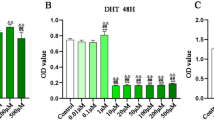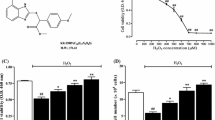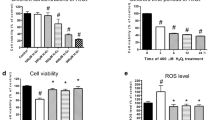Abstract
Oxidative stress and apoptosis is involved in hypoxia-reoxygenation (H/R) induced myocardial injury. Increased expression of uncoupling protein 2 (UCP2), a cationic carrier protein, has protective effect against H/R injury. The present study aimed to find candidate drugs for H/R induced cardiac damage by identifying compounds regulating UCP2 expression. Here, among six natural compounds, ursolic acid (UA) had the most significant induction effect on UCP2 expression in H9c2 cells under H/R conditions. Subsequently, we found that UA significantly attenuated cell apoptosis and Caspase 3 activity, but increased nitric oxide (NO) release under H/R conditions. Additionally, UA pretreatment also decreased reactive oxygen species (ROS) production and malondialdehyde (MDA) content, but increased superoxide dismutase (SOD) activity. H/R caused a notable increase in the phosphorylation of p38, which was weakened by UA pretreatment. Moreover, p38 inhibitor (SB203580) showed the similar effects on H/R cells as UA pretreatment, while UCP2 knockdown had the reverse biological effects. More importantly, the effects of UA or p38 inhibitor exposure were partially rescued by UCP2 knockdown. Collectively, our data suggested the functions of UA on UCP2 expression and on the protection of H/R-stimulated H9c2 cells may be attributed to p38 signaling pathway.





Similar content being viewed by others
References
Angeloni C, Spencer J, Leoncini E, Biagi P and Hrelia S 2007 Role of quercetin and its in vivo metabolites in protecting H9c2 cells against oxidative stress. Biochimie 89 73–82
Anu P, Mockridge JW, Farooqui S, Marber MS and Richard J 2000 Sustained activation of p42/p44 mitogen-activated protein kinase during recovery from simulated ischaemia mediates adaptive cytoprotection in cardiomyocytes. Biochem. J. 350 891–899
Ayyasamy V, Owens KM, Desouki MM, Liang P, Bakin A, Thangaraj K, Buchsbaum DJ, LoBuglio AF, et al. 2011 Cellular model of Warburg effect identifies tumor promoting function of UCP2 in breast cancer and its suppression by genipin. PLoS ONE 6 e24792
Blanc J, Alves-Guerra M, Esposito B, Rousset S, Gourdy P, Ricquier D, Tedgui A, Miroux B, et al. 2003 Protective role of uncoupling protein 2 in atherosclerosis. Circulation 107 388–390
Bolli R, Dawn B and Xuan Y-T 2003 Role of the JAK–STAT pathway in protection against myocardial ischemia/reperfusion injury. Trends Cardiovasc. Med. 13 72–79
Capano M and Crompton M 2006 Bax translocates to mitochondria of heart cells during simulated ischaemia: involvement of AMP-activated and p38 mitogen-activated protein kinases. Biochem. J. 395 57–64
Derdák Z, Fülöp P, Sabo E, Tavares R, Berthiaume EP, Resnick MB, Paragh G, Wands JR, et al. 2006 Enhanced colon tumor induction in uncoupling protein-2 deficient mice is associated with NF-κB activation and oxidative stress. Carcinogenesis 27 956–961
Diano S and Horvath TL 2012 Mitochondrial uncoupling protein 2 (UCP2) in glucose and lipid metabolism. Trends Mol. Med. 18 52–58
Emre Y, Hurtaud C, Nübel T, Criscuolo F, Ricquier D and Cassard-Doulcier A-M 2007 Mitochondria contribute to LPS-induced MAPK activation via uncoupling protein UCP2 in macrophages. Biochem. J. 402 271–278
Engelbrecht A-M, Niesler C, Page C and Lochner A 2004 p38 and JNK have distinct regulatory functions on the development of apoptosis during simulated ischaemia and reperfusion in neonatal cardiomyocytes. Basic Res. Cardiol. 99 338–350
Fleury C, Neverova M, Collins S, Raimbault S, Champigny O, Levi-Meyrueis C, Bouillaud F, Seldin MF, et al. 1997 Uncoupling protein-2: a novel gene linked to obesity and hyperinsulinemia. Nat. Genet. 15 269–272
Gao F, Gao E, Yue T-L, Ohlstein EH, Lopez BL, Christopher TA and Ma X-L 2002 Nitric oxide mediates the antiapoptotic effect of insulin in myocardial ischemia-reperfusion. Circulation 105 1497–1502
Garlid KD, Jabůrek M, Ježek P and Vařecha M 2000 How do uncoupling proteins uncouple? Biochim. Biophys. Acta Bioenerg. 1459 383–389
Gustafsson ÅB and Gottlieb RA 2009 Autophagy in ischemic heart disease. Circ. Res. 104 150–158
He B, Chen P, Yang L, Zhang X, Ji F and Shen Z 2009 Protective effects of 20 (R)-ginsenoside Rg3 on human umbilical vein endothelial cell injury induced by LPS. Chin. Pharmaceut. J. 44 1703–1707
Ikeda Y, Murakami A and Ohigashi H 2008 Ursolic acid: An anti‐and pro‐inflammatory triterpenoid. Mol. Nutr. Food Res. 52 26–42
Jeong JJ, Ha YM, Jin YC, Lee EJ, Kim JS, Kim HJ, Seo HG, Lee JH, et al. 2009 Rutin from Lonicera japonica inhibits myocardial ischemia/reperfusion-induced apoptosis in vivo and protects H9c2 cells against hydrogen peroxide-mediated injury via ERK1/2 and PI3K/Akt signals in vitro. Food Chem. Toxicol. 47 1569–1576
Kashyap D, Tuli HS and Sharma AK 2016 Ursolic acid (UA): a metabolite with promising therapeutic potential. Life Sci. 146 201–213
Keeley EC, Boura JA and Grines CL 2003 Primary angioplasty versus intravenous thrombolytic therapy for acute myocardial infarction: a quantitative review of 23 randomised trials. Lancet 361 13–20
Li G, Zhang X, You J, Song C, Sun Z, Xia L and Suo Y 2011 Highly sensitive and selective pre-column derivatization high-performance liquid chromatography approach for rapid determination of triterpenes oleanolic and ursolic acids and application to Swertia species: optimization of triterpenic acids extraction and pre-column derivatization using response surface methodology. Anal Chim. Acta 688 208–218
Luo H, Yuan S, Xiao J and Guo H 1997 Experimental study on the effect of ligustrazine on cultured vascular smooth muscle cells proliferation. West China J. Pharmaceut. Sci. 12 6–7
McCord JM and Edeas MA 2005 SOD, oxidative stress and human pathologies: a brief history and a future vision. Biomed. Pharmacother. 59 139–142
McLeod CJ, Aziz A, Hoyt RF, McCoy JP and Sack MN 2005 Uncoupling proteins 2 and 3 function in concert to augment tolerance to cardiac ischemia. J. Biol. Chem. 280 33470–33476
Moukdar F, Robidoux J, Lyght O, Pi J, Daniel KW and Collins S 2009 Reduced antioxidant capacity and diet-induced atherosclerosis in uncoupling protein-2-deficient mice. J. Lipid Res. 50 59–70
Pires ENS, Frozza RL, Hoppe JB, de Melo Menezes B and Salbego CG 2014 Berberine was neuroprotective against an in vitro model of brain ischemia: survival and apoptosis pathways involved. Brain Res. 1557 26–33
Ricquier D and Bouillaud F 2000 The uncoupling protein homologues: UCP1, UCP2, UCP3, StUCP and AtUCP. Biochem. J. 345 161–179
Rousset S, Emre Y, Join-Lambert O, Hurtaud C, Ricquier D and Cassard-Doulcier A-M 2006 The uncoupling protein 2 modulates the cytokine balance in innate immunity. Cytokine 35 135–142
Rupprecht A, Bräuer AU, Smorodchenko A, Goyn J, Hilse KE, Shabalina IG, Infante-Duarte C and Pohl EE 2012 Quantification of uncoupling protein 2 reveals its main expression in immune cells and selective up-regulation during T-cell proliferation. PLoS ONE 7 e41406
Seidlmayer LK, Juettner VV, Kettlewell S, Pavlov EV, Blatter LA and Dedkova EN 2015 Distinct mPTP activation mechanisms in ischaemia-reperfusion: contributions of Ca2+, ROS, pH, and inorganic polyphosphate. Cardiovasc. Res. 106 237–248
Selimovic D, Hassan M, Haikel Y and Hengge UR 2008 Taxol-induced mitochondrial stress in melanoma cells is mediated by activation of c-Jun N-terminal kinase (JNK) and p38 pathways via uncoupling protein 2. Cell Signal 20 311–322
Shi-Guang W, Yan X, Hao X, Wei W and Xiao-Hu C 2015 Astragaloside IV prevents lipopolysaccharide-induced injury in H9C2 cardiomyocytes. Chin. J. Nat. Med. 13 127–132
Shin EJ, Schram K, Zheng Xl and Sweeney G 2009 Leptin attenuates hypoxia/reoxygenation‐induced activation of the intrinsic pathway of apoptosis in rat H9c2 cells. J. Cell Physiol. 221 490–497
Sun, L, Isaak CK, Zhou Y, Petkau JC, Karmin O, Liu Y and Siow YL 2012 Salidroside and tyrosol from Rhodiola protect H9c2 cells from ischemia/reperfusion-induced apoptosis. Life Sci. 91 151–158
Teshima Y, Akao M, Jones SP and Marbán E 2003 Uncoupling protein-2 overexpression inhibits mitochondrial death pathway in cardiomyocytes. Circ. Res. 93 192–200
Tsai SJ and Yin MC 2008 Antioxidative and anti-inflammatory protection of oleanolic acid and ursolic acid in PC12 cells. J. Food Sci. 73 H174–H178
Uchida K 1999 Current status of acrolein as a lipid peroxidation product. Trends Cardiovasc. Med. 9 109–113
Wang Y-J, Lu J, Wu D-M, Zheng Z-H, Zheng Y-L, Wang X-H, Ruan J, Sun X, et al. 2011 Ursolic acid attenuates lipopolysaccharide-induced cognitive deficits in mouse brain through suppressing p38/NF-κB mediated inflammatory pathways. Neurobiol. Learn. Mem. 96 156–165
Wu H-J, Hao J, Wang S-Q, Jin B-L and Chen X-B 2012 Protective effects of ligustrazine on TNF-α-induced endothelial dysfunction. Eur. J. Pharmacol. 674 365–369
Yu H-H, Hur J-M, Seo S-J, Moon H-D, Kim H-J, Park R-K and You Y-O 2009 Protective effect of ursolic acid from Cornus officinalis on the hydrogen peroxide-induced damage of HEI-OC1 auditory cells. Am. J. Chin. Med. 37 735–746
Zhi-Juan WU, Jing YU, Wang RX, Fang QJ and Lin MJ 2014 Protective effect of ferulic acid on doxorubicin induced cellular injury in H9c2 myocardial cells. Chin. Pharmacol. Bull. 30 1059–1065
Author information
Authors and Affiliations
Corresponding author
Additional information
Communicated by Sorab Dalal.
Corresponding editor: Sorab Dalal
Rights and permissions
About this article
Cite this article
Chen, M., Wang, X., Hu, B. et al. Ursolic acid stimulates UCP2 expression and protects H9c2 cells from hypoxia-reoxygenation injury via p38 signaling. J Biosci 43, 857–865 (2018). https://doi.org/10.1007/s12038-018-9801-2
Received:
Accepted:
Published:
Issue Date:
DOI: https://doi.org/10.1007/s12038-018-9801-2




